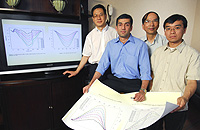(Georgia Institute of Technology: Atlanta) -- A new statistical analysis technique that identifies and removes systematic bias, noise, and equipment-based artifacts from experimental data could lead to more precise and reliable measurement of nanomaterials and nanostructures likely to have future industrial applications.
|
Georgia Tech researchers illustrate how their new technique improves measurement of nanostructure properties. Shown (l-r) are Zhong Lin Wang, V. Roshan Joseph, C.F. Jeff Wu and Xinwei Deng.
(Georgia Tech Photo: Gary Meek). |
Known as sequential profile adjustment by regression (SPAR), the technique could also reduce the amount of experimental data required to make conclusions, and help distinguish true nanoscale phenomena from experimental error. Beyond nanomaterials and nanostructures, the technique could also improve reliability and precision in nanoelectronics measurements—and in studies of certain larger-scale systems.
…

Add new comment